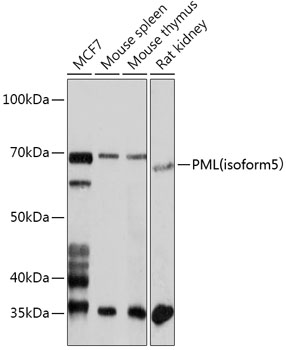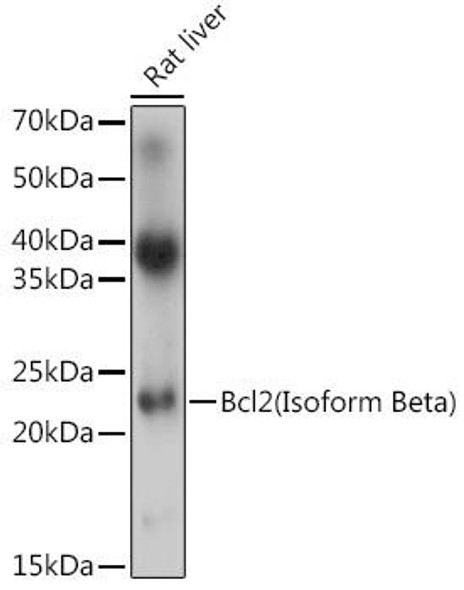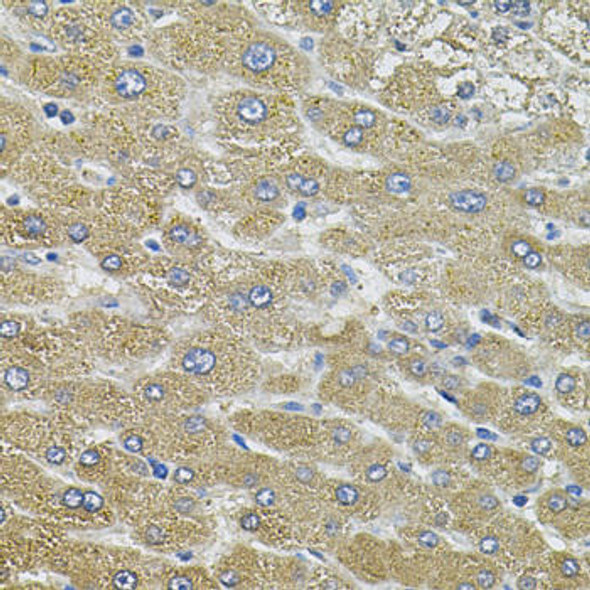Anti-PML?isoform 5? Antibody (CAB18182)
- SKU:
- CAB18182
- Product type:
- Antibody
- Reactivity:
- Human
- Mouse
- Rat
- Host Species:
- Rabbit
- Isotype:
- IgG
- Research Area:
- Immunology
Description
| Antibody Name: | Anti-PML?isoform 5? Antibody |
| Antibody SKU: | CAB18182 |
| Antibody Size: | 20uL, 50uL, 100uL |
| Application: | WB |
| Reactivity: | Human, Mouse, Rat |
| Host Species: | Rabbit |
| Immunogen: | Recombinant protein of human PML. |
| Application: | WB |
| Recommended Dilution: | WB 1:500 - 1:2000 |
| Reactivity: | Human, Mouse, Rat |
| Positive Samples: | MCF7, Mouse spleen, Mouse thymus, Rat kidney |
| Immunogen: | Recombinant protein of human PML. |
| Purification Method: | Affinity purification |
| Storage Buffer: | Store at -20°C. Avoid freeze / thaw cycles. Buffer: PBS with 0.02% sodium azide, 50% glycerol, pH7.3. |
| Isotype: | IgG |
| Sequence: | Email for sequence |
| Gene ID: | 5371 |
| Uniprot: | P29590 |
| Cellular Location: | Cytoplasm, Cytoplasmic side, Early endosome membrane, Endoplasmic reticulum membrane, Nucleus, PML body, Peripheral membrane protein, nucleolus, nucleoplasm |
| Calculated MW: | 47-48kDa/62-97kDa |
| Observed MW: | 67KDa |
| Synonyms: | MYL, PP8675, RNF71, TRIM19, PML |
| Background: | The protein encoded by this gene is a member of the tripartite motif (TRIM) family. The TRIM motif includes three zinc-binding domains, a RING, a B-box type 1 and a B-box type 2, and a coiled-coil region. This phosphoprotein localizes to nuclear bodies where it functions as a transcription factor and tumor suppressor. Its expression is cell-cycle related and it regulates the p53 response to oncogenic signals. The gene is often involved in the translocation with the retinoic acid receptor alpha gene associated with acute promyelocytic leukemia (APL). Extensive alternative splicing of this gene results in several variations of the protein's central and C-terminal regions; all variants encode the same N-terminus. Alternatively spliced transcript variants encoding different isoforms have been identified. |
| UniProt Protein Function: | PML: a zinc-finger protein that can regulate transcription and can localize to nuclear bodies. Cytoplasmic forms regulate glycolysis by inhibiting the tetrameric form of PKM2. Together with SATB1, involved in local chromatin-loop remodeling and gene expression regulation at the MHC-I locus. Interacts with SIRT1, TOPBP1, TRIM27 and TRIM69. Sumoylated forms interact with SATB1 and localize to the PML nuclear bodies. Sumoylation on three sites is required for nuclear body formation. Sumoylation on Lys-160 is a prerequisite for sumoylation on Lys-65. The B1 box and the RING finger are also required for localization to nuclear bodies. May play an important role in recruitment of ELF4 into PML nuclear bodies. A chromosomal aberration involving PML can cause acute promyelocytic leukemia (APL). Seven alternatively-spliced human isoforms have been reported. |
| UniProt Protein Details: | Protein type:Ubiquitin conjugating system; Tumor suppressor; Transcription factor; Nucleolus; Oncoprotein Chromosomal Location of Human Ortholog: 15q22 Cellular Component: nucleoplasm; PML body; nuclear membrane; nuclear matrix; early endosome membrane; cytoplasm; nucleolus; nucleus; cytosol Molecular Function:protein binding; protein homodimerization activity; SUMO binding; DNA binding; zinc ion binding; protein heterodimerization activity; ubiquitin protein ligase binding; transcription coactivator activity; SMAD binding; cobalt ion binding Biological Process: retinoic acid receptor signaling pathway; proteasomal ubiquitin-dependent protein catabolic process; viral reproduction; apoptosis; positive regulation of apoptosis involved in mammary gland involution; regulation of MHC class I biosynthetic process; PML body organization and biogenesis; SMAD protein nuclear translocation; DNA damage response, signal transduction by p53 class mediator resulting in cell cycle arrest; entrainment of circadian clock by photoperiod; negative regulation of cell proliferation; positive regulation of histone deacetylation; regulation of transcription, DNA-dependent; transforming growth factor beta receptor signaling pathway; response to gamma radiation; protein complex assembly; negative regulation of mitotic cell cycle; circadian regulation of gene expression; maintenance of protein localization in nucleus; cell cycle arrest; defense response to virus; negative regulation of telomere maintenance via telomerase; DNA damage response, signal transduction by p53 class mediator resulting in induction of apoptosis; response to UV; caspase activation; regulation of protein amino acid phosphorylation; cell fate commitment; protein stabilization; transcription, DNA-dependent; cytokine and chemokine mediated signaling pathway; common-partner SMAD protein phosphorylation; regulation of circadian rhythm; negative regulation of telomerase activity; endoplasmic reticulum calcium ion homeostasis; negative regulation of angiogenesis; DNA damage response, signal transduction resulting in induction of apoptosis; response to cytokine stimulus; response to hypoxia; innate immune response; myeloid cell differentiation; negative regulation of translation in response to oxidative stress; negative regulation of cell growth; positive regulation of defense response to virus by host; negative regulation of transcription, DNA-dependent; induction of apoptosis by oxidative stress; protein targeting |
| NCBI Summary: | The protein encoded by this gene is a member of the tripartite motif (TRIM) family. The TRIM motif includes three zinc-binding domains, a RING, a B-box type 1 and a B-box type 2, and a coiled-coil region. This phosphoprotein localizes to nuclear bodies where it functions as a transcription factor and tumor suppressor. Its expression is cell-cycle related and it regulates the p53 response to oncogenic signals. The gene is often involved in the translocation with the retinoic acid receptor alpha gene associated with acute promyelocytic leukemia (APL). Extensive alternative splicing of this gene results in several variations of the protein's central and C-terminal regions; all variants encode the same N-terminus. Alternatively spliced transcript variants encoding different isoforms have been identified. [provided by RefSeq, Jul 2008] |
| UniProt Code: | P29590 |
| NCBI GenInfo Identifier: | 15451765 |
| NCBI Gene ID: | 5371 |
| NCBI Accession: | NP_150242 |
| UniProt Related Accession: | P29590 |
| Molecular Weight: | 97.516 |
| NCBI Full Name: | protein PML isoform 9 |
| NCBI Synonym Full Names: | PML nuclear body scaffold |
| NCBI Official Symbol: | PML |
| NCBI Official Synonym Symbols: | MYL; RNF71; PP8675; TRIM19 |
| NCBI Protein Information: | protein PML |
| UniProt Protein Name: | Protein PML |
| UniProt Synonym Protein Names: | Promyelocytic leukemia protein; RING finger protein 71; Tripartite motif-containing protein 19 |
| Protein Family: | Protein |
| UniProt Gene Name: | PML |
| UniProt Entry Name: | PML_HUMAN |







![Anti-PML Antibody (CAB1184)[KO Validated] Anti-PML Antibody (CAB1184)[KO Validated]](https://cdn11.bigcommerce.com/s-39x6lpnvxv/images/stencil/590x590/products/18830/17030/anti-pml-antibody-cab1184ko-validated__99139__32028.1644251824.jpg?c=1)


